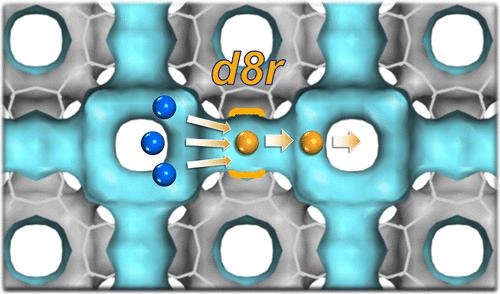Molecular Self-Gating Inside a Zeolite Catalyst
IF 14.4
1区 化学
Q1 CHEMISTRY, MULTIDISCIPLINARY
引用次数: 0
Abstract
Diffusion is a ubiquitous process that is strongly correlated with concentration. Based on developed three-dimensional free energy and a continuous-time random-walk coarse-graining method, we found the optimal diffusion pathway under confinement, determined all diffusional energy barriers, and identified the major units of zeolite where molecular diffusion is limited. Interestingly, a novel diffusion mechanism was determined in the nanopore of a zeolite catalyst by molecular dynamics simulation, pulsed field gradient, and 2D exchange spectroscopy (EXSY) NMR experiments. We describe a “molecular self-gating effect” that effectively predominates the diffusion process in cage-type (e.g., RHO and MER) zeolites through a “traffic jam” and a “smooth traffic” process. Initially, transport is hindered by molecules forming a gate (traffic jam); then, as the number of molecules reaches a certain threshold, diffusion increases rapidly due to the synergistic collisions of aggregated molecules upon the gate (smooth traffic). This unique diffusion behavior is observed here for the first time and illustrates a microscopic mechanism dictated by the molecular self-gating effect in a confined space. The exploitable diffusion disclosed herein should shed new light on the fundamental understanding of transport, as well as enrich diffusion behavior under confinement.

求助全文
约1分钟内获得全文
求助全文
来源期刊
CiteScore
24.40
自引率
6.00%
发文量
2398
审稿时长
1.6 months
期刊介绍:
The flagship journal of the American Chemical Society, known as the Journal of the American Chemical Society (JACS), has been a prestigious publication since its establishment in 1879. It holds a preeminent position in the field of chemistry and related interdisciplinary sciences. JACS is committed to disseminating cutting-edge research papers, covering a wide range of topics, and encompasses approximately 19,000 pages of Articles, Communications, and Perspectives annually. With a weekly publication frequency, JACS plays a vital role in advancing the field of chemistry by providing essential research.

 求助内容:
求助内容: 应助结果提醒方式:
应助结果提醒方式:


